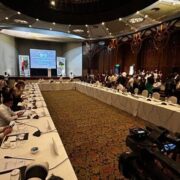Why US-Japan-PH maritime security ties endure

The tariff policies of the second Trump administration have shocked even allies, but security cooperation among willing nations supporting the Philippines has so far endured. For the first time, a Japanese frigate, JS Yahagi, participated in Balikatan 2025, the largest regular military exercise of the United States-Philippine alliance. The exercise lasted a little over a month from April 2025 and sought to strengthen cooperation with the Philippines, the United States, and Australia.
China believes that the mini-lateral security cooperation among US allies, which became active during the Biden administration, will continue under Trump because allies also bear the burden of US support for the Philippines. Such security cooperation is a low-cost and highly effective strategic tool for the US to contain China. It is difficult for any administration to abandon it.
From this perspective, China sees Japan as a convenient “pawn” that actively shares the burden of US support for the Philippines, while the Philippines is seen as a US “puppet state” set up to provoke China in the South China Sea.
In retrospect, when the Philippines took China to arbitration over the South China Sea, China viewed it as a “farce” masterminded by the US, manipulating the Philippines and Japan to go along. At the root of China’s understanding of the US-Japan-Philippines relationship is the belief that it is natural for a big power to subjugate a small one; in other words, China has a strong “great power bias” that ignores the determination of Japan and the Philippines not to succumb to Chinese pressure.
China believes that if it can just manage the US-China relationship, Japan and the Philippines will follow. Its “great power bias” is probably a natural way of thinking for China, which focuses on strategic competition with the United States. In the author’s experience, this is a question and answer that has been repeated many times with Chinese scholars, but it needs to be said again. China’s “great power bias” cannot accurately explain Japan’s security policy. For Japan, keeping the US in the region has been a traditional security issue, and its importance has not changed under the second Trump administration.
For more than a decade, the severe security environment has continued, with China challenging Japan’s control over the Senkaku Islands and exerting pressure on its maritime neighbors in the South China Sea, so Japan can’t be complacent about the US coming to its aid in a contingency. Similarly, Japan’s security cannot depend solely on the US’ “Asia First” policy, which prioritizes resources in the region.
In other words, Japan is not being prodded by the US, but is strongly motivated by the “unprecedented and the greatest strategic challenge” posed by China, as described in Japan’s National Security Strategy. In the face of China’s challenges, Japan has viewed the East China Sea and South China Sea as a single security space and has supported its maritime neighbor, the Philippines.
In 2013, the Japanese government signed a loan agreement with the Philippine government for the “Maritime Safety Capability Improvement Project for the Philippine Coast Guard (PCG).” Since 2016, Japan has provided the Philippines with ten 44-meter multipurpose vessels and, in 2022, delivered two 97-meter large patrol vessels. Japan will continue to build and deliver a total of five 97-meter patrol vessels to the PCG. In addition, Japan and the Philippines will hold a joint exercise with the coast guards of the three countries, including the US, off the coast of Kagoshima Prefecture in June 2025.
Japan’s efforts to build the PCG’s capabilities through the Aquino, Duterte, and Marcos administrations, with the Philippines firmly united by common security interests, underpins US engagement in the region to counter the threat from China. The US demonstrated its commitment by deploying the NMESIS, the most advanced land-to-ship missile system of the US Marine Corps, for the first time at Balikatan 2025.
However, on May 2, US National Security Advisor Michael Waltz, considered a hard-liner on China, was reassigned as US Ambassador to the United Nations. While US Ambassador to the Philippines MaryKay Carlson, who was appointed under the Biden administration, remains at her post as of May 2025, it won’t be surprising to see her replaced under the Trump administration.
Concerns remain about the sustainability of US engagement in the Philippines. There is no denying that Japan’s support for the Philippines through its Official Development Assistance may also gradually decline as Japan’s GDP shrinks. For the foreseeable future, however, Japan and the Philippines will continue their traditional work of deepening cooperation and maintaining a favorable environment for the US to remain in the region so as not to succumb to China’s maritime challenges.
—————
Aki Sakabe-Mori is assistant professor, Graduate School of Humanities and Social Sciences, University of Tsukuba.

















Strategic communication for gov’t programs